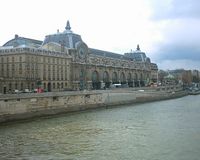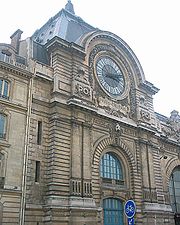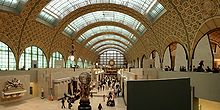
Gare d'Orsay
Encyclopedia

Paris
Paris is the capital and largest city in France, situated on the river Seine, in northern France, at the heart of the Île-de-France region...
railway station and hotel, built in 1900 to designs by Victor Laloux
Victor Laloux
Victor Alexandre Frederic Laloux was a French Beaux-Arts architect and teacher.- Life :Born in Tours, Laloux studied at the Paris École des Beaux-Arts atelier of Louis-Jules André, with his studies interrupted by the Franco-Prussian War, and was awarded the annual Prix de Rome in 1878...
, Lucien Magne and Émile Bénard
Émile Bénard
Henri Jean Émile Bénard , was a French architect and painter. Trained at the Beaux-Arts, Bénard was the winner of The Phoebe Hearst International Architectural Competition and the Berkeley Campus in 1899 with his project "Roma." The competition and his design led to the current University of...
; it served as a terminus for the Chemin de Fer de Paris à Orléans (Paris-Orléans
Orléans
-Prehistory and Roman:Cenabum was a Gallic stronghold, one of the principal towns of the Carnutes tribe where the Druids held their annual assembly. It was conquered and destroyed by Julius Caesar in 52 BC, then rebuilt under the Roman Empire...
Railway). It was the first electrified urban rail terminal in the world, opened 28 May 1900, in time for the 1900 Exposition Universelle
Exposition Universelle (1900)
The Exposition Universelle of 1900 was a world's fair held in Paris, France, from April 15 to November 12, 1900, to celebrate the achievements of the past century and to accelerate development into the next...
. After closure as a station, it reopened in December 1986 as the Musée d'Orsay
Musée d'Orsay
The Musée d'Orsay is a museum in Paris, France, on the left bank of the Seine. It is housed in the former Gare d'Orsay, an impressive Beaux-Arts railway station built between 1898 and 1900. The museum holds mainly French art dating from 1848 to 1915, including paintings, sculptures, furniture,...
, an art museum. The museum is currently served by the RER station of the same name
Musée d'Orsay (Paris RER)
Musée d'Orsay is a station in line C of the Paris Region's Réseau express régional rapid transit system, named after the Musée d'Orsay. It is situated in the 7th arrondissement of Paris.-Adjacent stations:...
.
History

Cour des Comptes
The Court of Audit is a quasi-judicial body of the French government charged with conducting financial and legislative audits of most public institutions and some private institutions, including the central Government, national public corporations, social security agencies , and public services...
was housed in the first floor. After the fall of the French Second Empire in 1870, the Paris Commune
Paris Commune
The Paris Commune was a government that briefly ruled Paris from March 18 to May 28, 1871. It existed before the split between anarchists and Marxists had taken place, and it is hailed by both groups as the first assumption of power by the working class during the Industrial Revolution...
created a provisional commission to replace the Conseil (March 1870 to August 1872), and the archives, library and works of art were removed to Versailles
Palace of Versailles
The Palace of Versailles , or simply Versailles, is a royal château in Versailles in the Île-de-France region of France. In French it is the Château de Versailles....
. Eventually both the Conseil and the Cour des Comptes were rehoused in the Palais-Royal.
The largely empty Palais d'Orsay burned to a shell in a spectacular fire the night of 23–24 May 1871, which was vividly described by Emile Zola
Émile Zola
Émile François Zola was a French writer, the most important exemplar of the literary school of naturalism and an important contributor to the development of theatrical naturalism...
.
The site was purchased by the Compagnie Paris-Orléans, which erected the monumental station in Beaux-Arts style, which takes its name from the Quai d'Orsay
Quai d'Orsay
The Quai d'Orsay is a quai in the VIIe arrondissement of Paris, part of the left bank of the Seine, and the name of the street along it. The Quai becomes the Quai Anatole France east of the Palais Bourbon, and the Quai de Branly west of the Pont de l'Alma.The French Ministry of Foreign Affairs is...
on which it stands, as the terminus for the railways of southwestern France. The western and southern sides of the building included a 370-room hotel.
By 1939 the station's short platforms had become unsuitable for the longer trains that had come to be used for mainline services, and the Gare d'Orsay was closed to long-distance traffic, though some suburban trains of the SNCF
SNCF
The SNCF , is France's national state-owned railway company. SNCF operates the country's national rail services, including the TGV, France's high-speed rail network...
continue to use its lower levels to this day. The hotel closed at the beginning of 1973.
The former station was used as a collection point for the dispatch of parcels to prisoners of war
Prisoner of war
A prisoner of war or enemy prisoner of war is a person, whether civilian or combatant, who is held in custody by an enemy power during or immediately after an armed conflict...
during the Second World War, and after the war as a reception centre for liberated prisoners on their return; a plaque on the side of the building facing the River Seine commemorates this latter use.
It served as the setting for several films, including Orson Welles
Orson Welles
George Orson Welles , best known as Orson Welles, was an American film director, actor, theatre director, screenwriter, and producer, who worked extensively in film, theatre, television and radio...
' version of Franz Kafka
Franz Kafka
Franz Kafka was a culturally influential German-language author of short stories and novels. Contemporary critics and academics, including Vladimir Nabokov, regard Kafka as one of the best writers of the 20th century...
's The Trial
The Trial (1962 film)
The Trial is a 1962 film directed by Orson Welles, who also wrote the screenplay based on the novel of the same name by Franz Kafka...
. It was in the ballroom of the station's hotel that General Charles de Gaulle
Charles de Gaulle
Charles André Joseph Marie de Gaulle was a French general and statesman who led the Free French Forces during World War II. He later founded the French Fifth Republic in 1958 and served as its first President from 1959 to 1969....
held the press conference at which he announced his "availability to serve his country" on 19 May 1958, ushering in the end of the French Fourth Republic
French Fourth Republic
The French Fourth Republic was the republican government of France between 1946 and 1958, governed by the fourth republican constitution. It was in many ways a revival of the Third Republic, which was in place before World War II, and suffered many of the same problems...
.
Museum

Musée d'Orsay
The Musée d'Orsay is a museum in Paris, France, on the left bank of the Seine. It is housed in the former Gare d'Orsay, an impressive Beaux-Arts railway station built between 1898 and 1900. The museum holds mainly French art dating from 1848 to 1915, including paintings, sculptures, furniture,...
in December 1986. The chief architect for the conversion was the Italian
Italy
Italy , officially the Italian Republic languages]] under the European Charter for Regional or Minority Languages. In each of these, Italy's official name is as follows:;;;;;;;;), is a unitary parliamentary republic in South-Central Europe. To the north it borders France, Switzerland, Austria and...
Gae Aulenti
Gae Aulenti
Gae Aulenti is an Italian architect, lighting and interior designer, and industrial designer. She is well known for several large-scale museum projects, including Musée d'Orsay in Paris , the Contemporary Art Gallery at the Centre Pompidou in Paris, the Palazzo Grassi in Venice , and the Asian Art...
. There is a huge clock which still works in the main terminal housing the museum.

